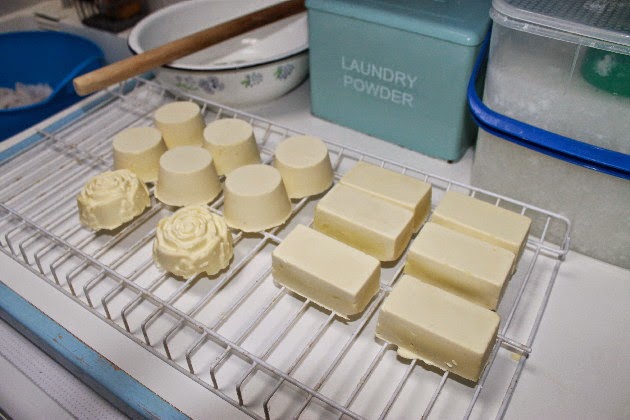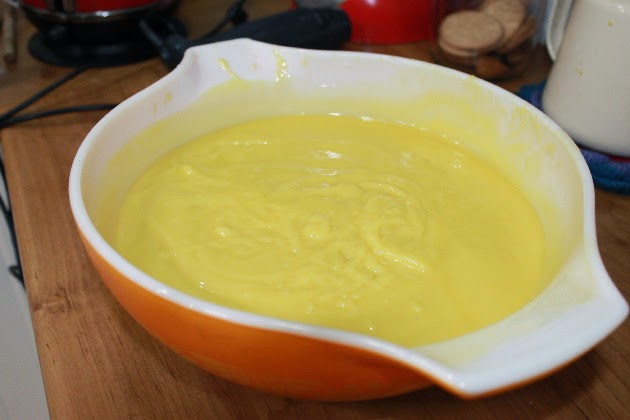This is the soap made last week using calendula-infused oil.
Your skin is your body's largest organ. What you put on your skin has the potential to heal or harm. I want to use products that at the very least, don't hurt me, and at their best, provide nourishing care for my skin and make me feel clean and cared for.
I hope I can encourage you to make your first batch of soap. But I have to start off with a warning. It can be dangerous because the caustic soda/lye you use will burn if you spill it. If you make soap when you're alone, with no children or animals around, you'll be able to focus all your attention on it and if you have the capabilities and intelligence of the hundreds of thousands of people who made soap before you did, you'll be fine. The danger point is mixing water with the caustic soda - the combination of those two elements will cause the mixture to heat up, even though it's not on the stove. Fumes will come off the mix so you must carry out that stage with doors and windows open. When the caustic soda/lye is mixed with the oils, the danger period is over, although the soap mix will still be slightly caustic. It sounds like something to be wary of but if we were together in your kitchen making soap, I'd simply say to you to be careful and I'd watch to make sure you were. Before and after that mixing of the caustic soda/lye, it's simply a matter of measuring and mixing.
Making calendula infused oil is quite simple. Early in the morning, after the dew has dried on the petals and after the bees have visited, but before the sun is high, pick the flower heads. This is when the oils in the flowers are at their best. Picking calendula flowers stimulates the plant to produce more so you can repeat the picking process every week until you have enough petals. Healing properties of calendula.
This is my new soap recipe:
450 mls/15.2 liquid oz of rain water, spring water or distilled water *
172 grams/6.06 oz caustic soda/lye
750 grams/26.5 oz olive oil
250 grams/8.8 oz calendula infused olive oil
250 grams/8.8 oz calendula infused olive oil
250 grams/8.8oz copha or coconut oil
* If you don't have rain, spring or distilled water, collect enough tap water the day before you make the soap and leave it on the bench to sit. That will allow the chlorine in the water to evaporate off.
All the instructions and equipment you'll need to make soap is listed in this post. Please read the entire post before going ahead, then come back here for the new recipe. Or if you have no infused oil, use the old recipe until you have time to make infused oil.
All the instructions and equipment you'll need to make soap is listed in this post. Please read the entire post before going ahead, then come back here for the new recipe. Or if you have no infused oil, use the old recipe until you have time to make infused oil.
When the soap mixture progresses from being liquid to a thicker consistency which holds a shape on the surface, the soap is ready to go into the moulds. This stage is called trace.
When the soap is made and poured into moulds, it needs to be kept warm for as long as possible. This (above) is how I do that. I place the moulds on a large board and cover the tops with plastic wrap, then cover that with a towel and wrap the entire thing in a woollen blanket. It sits on top of my freezer until the following day when I take the soap out of the moulds.
This soap can also be used for washing your hair and you don't need to use hair conditioner with it. I've used it for years and it's always made my hair shiny and healthy. Homemade soap is also a great gift. A bar of soap and two hand knitted face cloths is a beautiful gift that most people would love to receive. But I think the biggest benefits to making your own soap is knowing how few ingredients go into is and experiencing the nourishing qualities of the soap on a daily basis. And if you doubt that is a benefit, have a look at the list of ingredients on any supermarket soap.
I hope you take some time to learn the skill of soap making. Buying commercial supermarket soap will give you a lot more chemicals than it should and buying natural soap is expensive. Making your own from scratch is a natural progression in your simple life journey, so when you're ready to take that next step, I encourage you to dive right in.







